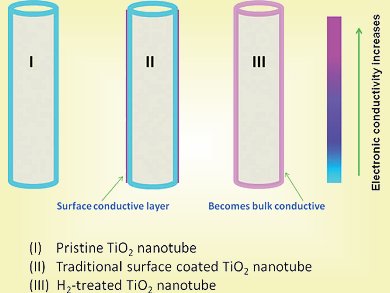Titanium dioxide is an attractive anode material for lithium-ion batteries because it is thermally and chemically stable as well as cheap. However, a disadvantage for its use centers on the transport problem in bulk materials caused by limited electronic conductivity.
Limin Zhou and co-workers, Hong Kong Polytechnic University, have overcome this limitation and improved the rate performance of TiO2 nanotubes by annealing the arrays in a reducing atmosphere (5 % H2 and 95 % Ar). This simple approach transforms the whole TiO2 nanotube layer into a highly conductive n-type semiconductor (see figure).
Furthermore, the high-rate capability of rutile TiO2 nanowire arrays and anatase TiO2 nanoparticles can also be considerably improved by similar means.
- Hydrogenated TiO2 Nanotube Arrays as High-Rate Anodes for Lithium-Ion Microbatteries,
Zhouguang Lu, Cho-Tong Yip, Liping Wang, Haitao Huang, Limin Zhou,
ChemPlusChem 2012.
DOI: 10.1002/cplu.201200104
This article is available for free as part of the ChemPlusChem free trial.



